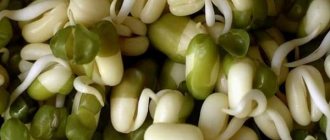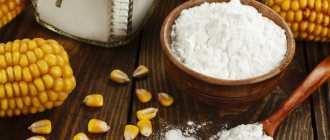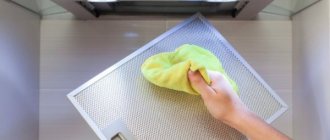Basic germination methods
To germinate beans at home, first prepare the seeds. To do this, the seed material is sorted. All dried and wrinkled grains are removed. Beans with signs of spoilage and rot are thrown away. After this, you can quickly germinate the beans at home for food or to grow on your own plot.
How to properly germinate seeds for food
The easiest way to obtain sprouts is to grow them in a flat glass plate. This process looks like this step by step:
- The selected seeds are laid out in one layer on a flat glass dish.
- Then they are covered with damp gauze and the dishes are left in a dark place.
- The gauze is regularly moistened to prevent it from drying out.
Already on the second or third day, small sprouts appear, and after 5-7 days they can be eaten. But many raw foodists eat such sprouts already on the second day after the start of germination.
How to germinate mung beans
Mung beans are small green beans. The sprouts of this legume are consumed as a main dish, added to salads, and used as an ingredient for stews or cutlets. Mung beans are sprouted using the same method as regular beans.
Important! To obtain sprouts from mung bean, only fresh crops are used. Otherwise, the resulting sprouts will contain very little useful substances. First, the mung beans are dipped in cold water for soaking.
After 10 hours, the grains are removed, washed and placed on a sieve. As a result of this soaking, the grains swell and soften. This treatment accelerates the emergence of sprouts
The mung beans are first dipped in cold water for soaking. After 10 hours, the grains are removed, washed and placed on a sieve. As a result of this soaking, the grains swell and soften. This treatment accelerates the emergence of sprouts.
To germinate mung beans, use a small plastic bucket or container with holes made in the bottom. They will get rid of excess liquid in the container. This significantly reduces the likelihood of mold formation.
The bottom of the container is covered with dry gauze. Pre-soaked grains are spread on it in a thin layer. They are sprayed with water and covered with a clean cloth. The container is left for a day in a darkened room. The moisture gradually evaporates. Therefore, every 3 hours the mung beans are sprinkled with water again. The first shoots appear within a day. They can be eaten immediately or wait another 2-3 days.
How to germinate bean seeds in 1 day
To ensure rapid emergence of sprouts, ensure constant hydration of the tissue in which the beans are located. For some varieties, pre-soaking is used. This also speeds up germination. To germinate seeds overnight, growth stimulants are added to the water. The very next day the sprouts will hatch and the seeds can be planted.
The easiest way to quickly sprout grains for food is to place them in a damp cloth. Then the sprouts hatch the next day or every other day. After this they can be eaten.
How to germinate beans for planting
In this case, the roll growing method is used. For this you will need thick polyethylene and toilet paper. A strip equal to the width of toilet paper is cut from a piece of polyethylene. It is laid out on the table and moistened with water. Apply toilet paper along the entire length on top. The selected seeds are laid out in a row, 2 cm from the top edge. Then cover everything with another layer of toilet paper and spray everything with water from a spray bottle.
The entire structure is rolled up and secured with an elastic band so that it does not fall apart. Then pour some water into a wide container and dip the roll of seeds with the free end into the liquid.
After a few days, seedlings appear, but they are not yet strong enough to be planted in the soil. They are grown in rolls for another 10 days before being transplanted into the ground.
Important! Bean seeds cannot be germinated in soil. In this case, they are immediately planted to grow plants.
Germination on cotton balls
This method is often used in school experiments to monitor the development of a plant. Any healthy beans from the store will do for this sprouting. Place a cotton pad in a low glass container and place healthy beans on it. The cotton wool is moistened with water and the container is left in the light in a warm place. After a few hours, the germination process begins and the first shoots hatch. Then you can watch how the beans sprout, take photos or film the process.
Project “Is it possible to grow beans on a window?”
Serbina Anna
Project “Is it possible to grow beans on a window?”
We knew that plants needed heat and light, moisture, air to grow.
To find out how to germinate a bean , my parents and I searched for information using the Internet, a story from an experienced person (a grandmother gardener, an encyclopedia.
Before the experiment, we measured the bean and examined it in cross-section.
With the help of the encyclopedia, we learned how the seed works. It consists of a seed coat, cotyledons and an embryo. The seed coat protects the seed from damage and drying out. The cotyledons contain nutrients for the embryo
How we sprouted beans .
We took two containers (iron plates)
.
In one, the bean were completely filled with water, and in the other, the bean were placed on damp cotton pads. Both containers (plates)
were placed in the light - the windowsill.
After 2 days in a plate with water, the beans swelled and the water turned red.
In a plate with cotton pads, the beans have increased significantly and the cotton pads have become colored.
After 4 days, the beans with water remained unchanged, but the bean with wet disks sprouted.
On day 5, some beans began to have roots :
The beans , in a bowl completely filled with water, swelled, but did not germinate because there was no air. Beans on moist disks sprouted because they were in favorable conditions for growth - moisture, air, heat.
Conclusion: water, air and heat are vital for seed germination.
Next - on Friday we planted the sprouted beans in fertilized loose soil
and already on Monday we saw sprouts:
On the third day a green leaf appeared. The green leaf grew very quickly. He reached for the light and we continued to water him. Other beans . Leaves appeared. The leaves were green and tender. Every day there were more and more leaves.
We observed the growth of beans and recorded all changes in an observation diary.
one seed of sprouted beans in a transparent box and observed what happened to the seed underground. We saw the following:
First, the seed had a root, it was directed downwards, as it needed soil and water.
“Climbed out” at the top
sprout and headed up towards the light.
Beans shed their shell - the peel.
The first leaves appear on the new plant. Bottommost (first)
The leaves are different from others: they are semicircular. We learned from the encyclopedia that they are called cotyledons.
At of the beans were tender and weak.
Every day they became longer. The beans grew very quickly , this was noticeable by the ruler stuck into the ground nearby.
Conclusion: seeds need water, soil, light, warmth, our care and attention to germinate and grow successfully. And in order for the pods to grow and the beans , WE THINK - they need to be planted in the garden, that is, in open ground.
We will continue to watch our beans on the window .
We also made a collection of beans
Educational and research project “Mrs. Beans” PROJECT “Mrs. Beans” Project manager Rimma Vladimirovna Rybalko. Project type: research. Project type: short-term (February.
Project “Vegetable garden on the window” Project: short-term. Type of project: educational and research Project duration: 2 months Project participants: educator, Project “Vegetable garden on the window” PROJECT “GARDEN ON THE WINDOW” “Give children the joy of work! This joy is brought to him by success, awareness of his skill and the importance of the work he does. Project “Vegetable Garden on the Window” Relevance: In the modern world, children, including preschoolers, are increasingly interested in computer games, consoles, and phones. Project “Vegetable Garden on the Window” » Kindergarten No. 56 “Sun” Secondary group No. 2 Educator: Lyashenko T. I. Belgorod 2016 Project “Vegetable Garden on the Window” Project type: creative, Project “Garden on the Window” Project “Vegetable Garden on the Window” in the preparatory group Type of project : educational – practical. Project participants: Teacher, students.
Project “Vitamins on the Window” Project passport Institution: Municipal government preschool educational institution “Mama’s Kindergarten” Project topic: “Vitamins.
Project “What kind of greenery is on the window” Project duration - 4 weeks Project type - educational Project goal: To form the foundations of environmental culture in children.
Lesson in the middle group “Peas and beans” Lesson for middle-aged children. "Introduction to the properties of peas and beans." Goals: formation of cognitive and research.
What and how to feed beans?
An annual plant will not require additional nutrition if the planting soil is prepared correctly. If the beans begin to lag behind in development or the foliage begins to turn yellow, this means that it is necessary to apply nitrogen fertilizer. Spring is the time for organic or nitrogen mineral fertilizer. Summer and early autumn - potassium and phosphorus must be added to the soil.
It is not recommended to apply manure at home; in these conditions, the best option is to purchase a ready-made balanced solution. After dilution in the proportion specified in the instructions for use, the composition is watered on the moistened soil in pots, and after the moisture is absorbed, watered with warm water.
For vines, in addition to root feeding, you will need to carry out foliar feeding of the plants. To do this, you can mix the solution yourself, but it is better to purchase an industrial balanced composition and spray all parts of the plant and the soil in the pot.
How to calculate seed germination time
There are two options for the development of events:
1. Sowing dry seeds in a seedling container or garden bed.
Everything is simple here. As soon as the seeds fall into the moistened soil, they will begin to germinate and after a few days (see tables below) shoots will appear above the soil surface. If the sown seeds are at the optimal temperature, there will be no delays in germination. Lower temperatures will slow down the germination process or stop it altogether.
2. Wetting the seeds until they swell or peck, followed by planting.
If you decide to wet the seeds first, start counting from that moment. Moisture, coupled with the optimal temperature, makes the seeds wake up, no matter where they are - in a cloth on a saucer or in a garden bed.
For example, the germination period of tomato seeds is 4-8 days. If you soaked the seeds for a day in a damp cloth, and then sowed the seedlings in a box with moist soil (and kept the seed at 25-27°C all the time), then expect sprouts to appear in 3-7 days. The fastest results will be shown by fresh, high-quality seeds with high germination energy.
The germination period can be shortened if you use not ordinary water to soak the seeds, but a solution of some growth stimulator (Epin Extra, Zircon, Energen Aqua, HB-101, Ecosil, etc.).
Below are tables that will tell you how long to wait for the seeds of popular crops grown in our summer cottages to sprout, from vegetables to flowers.
Germination time of vegetable seeds
| Culture | Period from sowing to emergence (days) | Optimal germination temperature (°C) | Retention of germination (years) |
| Watermelon | 6-12 | 25-30 | 6-7 |
| Eggplant | 8-14 | 25-27 | 3-4 |
| Vegetable bean | 7-12 | 18-20 | 5-6 |
| Swede | 3-6 | 17-20 | 4-5 |
| Vegetable cowpea | 7-12 | 18-20 | 5-6 |
| Vegetable peas | 4-8 | 16-20 | 5-6 |
| Daikon | 3-6 | 18-20 | 4-5 |
| Melon | 4-8 | 25-30 | 6-7 |
| Zucchini | 4-8 | 25-27 | 6-7 |
| White cabbage | 3-6 | 17-20 | 4-5 |
| Broccoli | 3-6 | 17-20 | 4-5 |
| Brussels sprouts | 3-6 | 17-20 | 4-5 |
| Kohlrabi cabbage | 3-6 | 17-20 | 4-5 |
| Cauliflower | 3-6 | 17-20 | 4-5 |
| Kruknek | 4-8 | 25-27 | 6-7 |
| Sweet corn | 10-15 | 20-25 | 3-5 |
| Lagenaria | 4-8 | 25-27 | 6-7 |
| Leek | 8-14 | 18-20 | 2-3 |
| Bulb onions | 8-14 | 18-20 | 2-3 |
| Carrot | 12-22 | 20-25 | 3-4 |
| Chickpeas | 4-8 | 16-20 | 5-6 |
| Cucumber | 4-8 | 25-27 | 6-7 |
| Parsnip | 12-22 | 20-25 | 1-2 |
| Squash | 4-8 | 25-27 | 6-7 |
| Pepper | 8-14 | 25-27 | 3-4 |
| Parsley root | 12-22 | 18-22 | 2-3 |
| Radish | 3-6 | 17-20 | 4-5 |
| Radish | 3-6 | 17-20 | 4-5 |
| Turnip | 3-6 | 17-20 | 4-5 |
| 4-8 | 20-22 | 3-4 | |
| Celery root | 12-22 | 20-25 | 1-2 |
| Scorzonera | 10-14 | 12-15 | 1-2 |
| Vegetable soybean | 4-8 | 16-20 | 5-6 |
| Tomato | 4-8 | 25-27 | 5-6 |
| Pumpkin | 4-8 | 25-27 | 6-7 |
| Vegetable beans | 7-12 | 18-20 | 5-6 |
| Lentils | 4-8 | 16-20 | 5-6 |
Germination time of seeds of green and spicy-flavoring crops
| Culture | Period from sowing to emergence (days) | Optimal germination temperature (°C) | Retention of germination (years) |
| Anise | 12-22 | 20-25 | 2-3 |
| Basil | 12-20 | 20-25 | 3-4 |
| Borago | 5-10 | 18-22 | 3-4 |
| Salad mustard | 3-6 | 17-20 | 3-4 |
| Oregano | 14-20 | 20-25 | 3-4 |
| Hyssop | 14-20 | 20-25 | 2-3 |
| Mizuna cabbage | 3-6 | 17-20 | 4-5 |
| Pak choi cabbage | 3-6 | 17-20 | 4-5 |
| Katran | 3-6 | 17-20 | 3-4 |
| Chervil | 12-22 | 20-25 | 3-4 |
| Coriander | 12-22 | 20-25 | 3-4 |
| Watercress | 4-8 | 17-20 | 3-4 |
| Onion | 8-14 | 18-20 | 2-3 |
| Slime Bow | 8-14 | 18-20 | 2-3 |
| Lovage | 12-22 | 20-25 | 3-4 |
| Marjoram | 14-20 | 20-25 | 2-3 |
| Chard | 4-8 | 20-20 | 3-4 |
| lemon balm | 14-20 | 20-25 | 2-3 |
| Monarda | 14-20 | 20-25 | 2-3 |
| Peppermint | 14-20 | 20-25 | 2-3 |
| Leaf parsley | 12-22 | 18-22 | 2-3 |
| Rhubarb | 10-22 | 15-17 | 2-3 |
| Rosemary | 14-20 | 20-25 | 2-3 |
| Arugula | 3-6 | 17-20 | 4-5 |
| Salad | 4-8 | 17-20 | 3-4 |
| Leaf celery | 12-22 | 20-25 | 1-2 |
| Thyme | 14-20 | 20-25 | 2-3 |
| Caraway | 12-22 | 20-25 | 2-3 |
| Dill | 12-22 | 20-25 | 2-3 |
| Fennel | 12-22 | 20-25 | 2-3 |
| Chives | 8-14 | 18-20 | 2-3 |
| Spinach | 4-8 | 20-22 | 3-4 |
| Sorrel | 12-15 | 15-18 | 2-3 |
| Tarragon | 14-22 | 18-22 | 2-3 |
Timing of germination of flower seeds
| Culture | Period from sowing to emergence (days) | Optimal germination temperature (°C) | Retention of germination (years) |
| Ageratum | 10-12 | 18-22 | 2-3 |
| Amaranth | 4-8 | 20-22 | 5-6 |
| Aster | 6-10 | 18-20 | 1-2 |
| Balsam | 10-15 | 20-22 | 3-5 |
| Marigold | 4-6 | 18-20 | 2-3 |
| cornflower | 8-12 | 18-20 | 2-3 |
| Verbena | 12-20 | 20-22 | 2-3 |
| Gaillardia | 7-14 | 20-22 | 2-3 |
| Gatsania | 7-14 | 18-20 | 1-2 |
| Chinese carnation | 6-7 | 20-22 | 3-4 |
| Carnation Shabo | 6-10 | 16-18 | 3-4 |
| Dahlia annual | 7-8 | 23-25 | 2-3 |
| Godetia | 10-14 | 15-18 | 3-4 |
| sweet pea | 5-8 | 16-20 | 5-6 |
| Delphinium | 7-14 | 8-10 | 1-2 |
| Dimorphotheca | 7-11 | 18-20 | 1-2 |
| Iberis | 5-7 | 16-18 | 2-3 |
| morning glory | 10-12 | 22-25 | 3-4 |
| Calendula | 4-7 | 18-20 | 2-3 |
| Clarkia | 10-14 | 15-18 | 3-4 |
| Cosmea | 12-14 | 18-20 | 3-5 |
| Lavender | 14-20 | 20-25 | 2-3 |
| Lavatera | 14-20 | 20-22 | 3-4 |
| Levkoy | 4-6 | 17-20 | 4-5 |
| Lobelia | 7-12 | 25-27 | 2-3 |
| Lobularia | 4-6 | 17-20 | 3-5 |
| Snapdragon | 12-16 | 18-20 | 3-4 |
| Mattiola | 4-6 | 17-20 | 2-3 |
| Nasturtium | 12-16 | 22-25 | 3-4 |
| Nivyanyk | 7-12 | 20-22 | 2-3 |
| Pelargonium | 10-14 | 22-24 | 2-3 |
| Petunia | 10-14 | 22-25 | 4-5 |
| Rudbeckia | 7-12 | 20-22 | 2-4 |
| Salvia | 14-20 | 20-25 | 2-3 |
| Sweet tobacco | 10-14 | 23-25 | 3-4 |
| Phlox Drummond | 5-9 | 18-22 | 1-2 |
| Celosia | 8-14 | 20-25 | 3-5 |
| Zinnia | 5-10 | 18-20 | 2-3 |
| Stock rose | 14-20 | 20-22 | 3-4 |
| Echinacea | 10-14 | 18-20 | 2-4 |
| Eschszolzia | 12-16 | 22-25 | 3-4 |
Knowing the period of germination of seeds of a particular crop, you can calculate the optimal time for sowing them for seedlings. Or, without wasting time, repeat sowing if you suddenly do not get shoots from low-quality seeds. But we hope that the last trouble will bypass you, and in the coming season you will easily achieve a rich harvest of vegetables and lush flowering of ornamental plants.
Source
Why are beans sprouted?
Bean seeds contain harmful phytic acid. It acts as an inhibitor of food enzymes. As a result of germination, this substance loses its properties. Then the seeds are freed from this useless element, and the human body more fully assimilates the valuable substances hidden in them.
When bean seeds germinate, complex plant proteins are quickly converted into amino acids with a simple structure. As a result of consuming such a product, the digestion process is faster and easier. The body does not experience heaviness in the stomach, and gases do not form in the intestines.
If legume sprouts are germinated for further growing plants, their vitamin content increases. The product is enriched with rutin, tocopherol, vitamins K and D. The concentration of vitamins from group B also increases. At the same time, the content of vitamin E increases almost 10 times. Also, germination of seeds provokes the growth of enzymes. According to some studies, their number increases 100 times. Therefore, such preliminary preparation of seeds facilitates the digestion of products.
Sprouted beans have a different nutritional value. Compared to seeds that have not undergone pre-treatment, the amount of protein in sprouts increases by a third and the carbohydrate content decreases by 15%.
On a note! Seed germination is often used for interesting experiments at school.
Not all varieties of bean sprouts are suitable for eating.
It may be interesting Making garden beds at your dacha with your own hands using scrap materials and recyclable materials Chanterelle mushrooms and their medicinal properties Bean shells: medicinal effect on the body, recipes for traditional medicine
Some of them contain toxic substances that can cause poisoning. They are destroyed only during heat treatment.
It is allowed to eat sprouts from the following varieties of beans:
- black;
- azuki;
- pinto;
- mung bean;
- mung.
When buying bean sprouts in a store or market, you cannot eat them raw. Such sprouts must be subjected to heat treatment. Seeds are germinated in a warm and humid environment, which is favorable for the development of dangerous microflora.
How to calculate seed germination time
Adding an article to a new collection
Beginners, having sowed seeds for seedlings or in the ground, are at a loss as to how long they will have to wait for germination. There is no need to languish in anticipation - we have compiled convenient tables of seed germination times for a wide variety of crops.
The germination period is the period during which the seed has time to sprout and sprout. Sufficient humidity and comfortable ambient temperature contribute to successful seed germination (seeds of some crops also need good lighting).
The benefits of sprouts and how to add them to the menu
Sprouted beans have high nutritional value; they are eaten as an independent dish, used to make salads or as a component of more complex treats. In their raw form, beans go well with fresh herbs, berries and fruits. Bean sprouts are also a main ingredient in many Asian recipes, be it Chinese, Indian or Korean. They are even used for baking.
The most useful combination is considered to be sprouted beans and oat sprouts. They complement each other perfectly and provide the body with a large supply of nutrients, minerals and vitamins.
When using for the first time, you need to be careful and not get carried away with a large number of sprouts. First they are tasted, for example, in the form of a sauce, then as an ingredient in a salad
After each test, you need to observe the body's reaction.
If an allergic reaction occurs, sprouted beans should be discarded. If no unpleasant reactions occur, then the portion of sprouts is gradually increased, but you should not abuse it, 100-150 grams per day is enough (this is about 2 tbsp. L).
Reviews
Marina, 25 years old:
I sprout beans for food. They help you feel full and prevent you from gaining extra pounds. With their help, I have already lost 3 kg without any effort.
Elena, 35 years old:
At school, my daughter was asked to do an experiment on sprouting beans. We sprouted it in a jar with moistened cotton wool, and then recorded all the changes with the beans in the photo. It turned out to be very exciting.
Obtaining sprouts from beans speeds up the ripening of the crop and allows for uniform plant shoots. Sprouted beans are especially useful as a dietary food. They provide a lot of protein, promote weight loss and improve the condition of certain diseases.
Home growing technology
Beans can be planted in a pot or flowerpot. She feels great on the open balcony, in the glassed-in loggia. The northern side is not recommended; in this case, you will have to organize additional lighting for the bush so that it can fully develop. A climbing plant will decorate a winter garden or home greenhouse. With proper care, you can get a good harvest of fruits.
Selection of varieties
Low-growing bush hybrid or self-pollinating varieties are suitable for home and balcony cultivation. Early ripening asparagus produces compact bushes that are easy to care for. Usually, varieties with different bud colors are chosen, and several types of plants are planted at once. In addition to technological varieties, decorative varieties of beans are selected.
They resemble thickets of vines. The seeds do not differ in taste and rarely ripen, but the lush flowering lasts a long time. Popular varieties: Violetta, Krapinka, Rumba are resistant to diseases and pests.
Planting and care
Agricultural technology for home cultivation is no different from garden cultivation. For the aesthetic design of the balcony, it is recommended to plant seedlings in stages at weekly intervals. The plant needs a light interval of at least 12 hours; in winter, seedlings for balconies and loggias are illuminated at home. The optimal time for planting seeds is mid-May. To obtain early flowers and fruits, beans are planted in early April. Then the plant is gradually accustomed to balcony conditions: first taken out into the air for 20 minutes, then brought in only at night; when the weather is warm, the beans are left in the open air.
Fertilizers are applied during watering. The fertilizer is diluted according to the instructions, then the volume of water is doubled. Seedlings and bushes love evening spraying; a lot of dust settles on the leaves; there is no natural airflow or dew formation in an apartment or balcony.
It is important to monitor the condition of the trellises. Under the weight of the fruit, thin threads and garters periodically break
Growing beans after germination
This garden crop loves warmth and does not tolerate low air temperatures. Therefore, it is planted in open ground only after warm weather has finally established itself. This usually occurs in May, depending on the climate and weather conditions.
For planting, choose an open area where the plants will have enough sunlight. The soil in the chosen location should be light and loose, without close proximity to groundwater. Before planting the plants, the soil is loosened.
Selecting a bean variety for your home
Beans come in climbing and bush varieties. Each type is divided into asparagus, shelling and decorative. The choice of a specific variety is influenced by the characteristics of the climatic zone and the place where the plant will be located.
Hulling varieties are also called grain varieties. They use only the grains themselves for food. The pod valves of these varieties are too hard to eat. These varieties love warmth and ripen for a very long time. For this reason, they are grown only in the southern regions.
Green bean pods do not contain any hard fibers. Therefore, they can be eaten. Fruiting of these varieties begins two months after germination. At the same time, the crop ripens gradually. It is collected in batches before the cold weather arrives.
Ornamental varieties are needed to improve the quality of the soil and decorate the garden. These beans enrich the soil with nitrogen, which is extracted by plants from the air. This element is necessary for the rapid growth of Solanaceae and other plants.
On a note!
If you plant beans nearby, the plants will suffer less from late blight.
Bush varieties can be grown as indoor plants. Their root system does not exceed 20 cm in length, and the height of the shoots is up to 50 cm. Therefore, the plants do not take up much space and fit in a standard flower pot. There is no need to tie them up and build a support for the lashes. In addition, such beans ripen very quickly.
Climbing varieties are usually used for growing in open ground. They have a long root system and developed vines. These beans bear fruit abundantly. It is often used to decorate gazebos, arches and other decorative structures.
How to plant beans in a pot
For seedlings, grains are planted in small containers filled with a nutritious soil mixture consisting of peat and humus. A depression is made in the center of the container and the dry or sprouted grain is placed in it to a depth of 3-4 cm. The prepared pots with seeds are placed on a lighted windowsill, where the temperature exceeds +20 degrees. After 2-3 weeks, the seedlings will have grown enough to be transplanted into an open area.
Planting in open ground and caring for it
After preparing the site, holes are made in the garden bed and the prepared sprouts are placed in them to a depth of 5 cm. Bush varieties are planted at a distance of 15 cm; for others, the optimal interval is 10 cm. Compost is placed at the bottom of the planting hole to provide the plant with useful substances.
Before planting sprouted seeds, the bed is watered with warm water. The beans are placed horizontally, covered with soil and watered with a small amount of water.
Caring for plants involves regular irrigation, clearing weeds and loosening the soil. This crop needs air to reach the roots. Therefore, between waterings, the soil must be loosened to a shallow depth so as not to disturb the root system of the plant. Watering should be moderate; too much watering causes rotting of the root system. If there is not enough moisture, the ovaries and flowers fall off.
Harvesting
When to pick ripe beans, they decide based on their variety. Asparagus varieties are picked twice a week. Less frequent harvesting causes the fruit to become overripe. Ripe pods are cut with scissors to avoid damaging the stem.
The peeling varieties are picked after full ripening. The green ones are left on the plant to ripen. The degree of maturity of the pod is determined by breaking it. When scrapped, the edges of the halves will be smooth, without traces of fibers.
Important!
Immediately after removal, the beans are removed from the pod. They cannot be stored unpeeled for a long time. The shell accumulates moisture and the grains may become moldy.
Before being sent for storage, the beans are dried in the sun. For storage, the collected beans are placed in linen bags or placed in sealed jars.
Diseases and pests of beans
At home, diseases and pests are not harmful to plants if the windows are covered with mosquito nets and the seeds and soil have been disinfected during preparation. But there are situations when gray rot forms on the bean trunk near the roots, or when overwatering, a fungal disease appears - blackleg. The larvae of various pests, for example, aphids and leaf rollers, can settle on beans.
In such cases, the bushes should be immediately treated with solutions of contact fungicides and insecticides
But when purchasing, pay attention to the volume of the solution. To treat several bushes, you should not purchase a product for preparing 10 or 5 liters of solution
Sprouting legumes for food use
Eating legume sprouts brings extraordinary benefits to the body. Sprouted seeds contain much more useful microelements than regular beans. No wonder they are called “living food”. The easiest way to sprout beans for food is to place them in a flat glass container, cover with damp gauze and put them in a dark place. This method will eliminate excess moisture. Already on the 2-3rd day, sprouts appear; once they reach 5-7 cm, they can be eaten. Although many raw foodists prefer to eat sprouts on the second day. As you can see, germinating beans this way is quite simple.
Preparing seeds and soil for planting
Dry seeds do not germinate well, but soaking them is not recommended because they will rot in frozen soil.
Seed preparation technology step by step:
- Place them in a plastic container and fill them with a hot solution of potassium permanganate (70 0C), prepared in low concentration.
- Sow the seeds immediately and fill with the remaining solution.
Another way: prepare a potassium solution at a water temperature of 60 0C and pour it into the ground. After this, immediately sow the beans.
It is important to loosen the soil well and, if necessary, add a deoxidizing agent if the acidity is high. Chalk, ash or dolomite is used as a deoxidizer
How to grow lychees from seeds at home Do you want to grow lychees at home? We will tell you how to do it correctly. And also everything about caring for sprouted...
Planting germinated material in the ground
The seeds should not be allowed to outgrow, otherwise the roots will begin to intertwine with each other. When separated, fragile seedlings may break, which will affect the germination of grains. Beans are planted in the second half of spring. By this time the earth is warming up, and the threat of return frosts has passed. This is important because the legume crop is not frost-resistant; even minor frosts can destroy it. The place for planting beans is chosen to be well-lit, with loose, breathable soil. The grains are planted sideways in the ground so as not to damage the roots.
Holes are dug 5-6 centimeters deep, watered, seeds are placed in them, and covered with earth. The distance between plantings is 20-30 centimeters. If the grains are planted in dry soil, there is no need to germinate them.
Additional Information. According to popular wisdom, beans can be planted after the chestnuts begin to bloom.
Part I: Preparation
For the experiment, we chose red bean seeds to see how the color of the seeds would change during the germination process. We measured the beans and looked inside
- Check out the most popular care products
- Preserve the beauty and natural health of your skin
- Create a new look with the brand's collection of the season
- Create a special mood for any holiday or event
More details
The beans bought at the nearest store turned out to be approximately the same size, about one and a half centimeters. Each of them can be split into two halves - cotyledons - these are nutrients for the future sprout until it gets stronger. The photo shows a plant embryo with a pair of leaves. The cotyledons and embryo are covered with a dense membrane. The inside of the cotyledon is the same color in both white and colored beans. The only difference is the color of the shell and the size of the beans.
We will have three samples participating in the experiment: Sample 1 - will simply lie in the light and heat. Sample 2 – will lie in a glass of water. Sample 3 – will lie on a piece of cotton wool moistened with water. Thus, we will find out which conditions are best for bean germination.
Seed structures with photos and their meaning
The seed is formed after fertilization from the ovule and carries the embryo. The embryo contains two cotyledons or embryonic leaves, an embryonic root and an embryonic shoot. The skin protects the embryo from drying out and damage. Let's take a closer look at the structure of the bean seed embryo.
Embryonic shoot of a dicotyledonous plant
The embryonic shoot consists of a subcotyledon (hypocotyl) and a bud.
The bud has a growth cone and several leaf primordia. The main shoot of the plant develops from these organs.
The subcotyledonous knee is located between the cotyledonous node, from which the cotyledons extend, and the embryonic root. It looks like a stalk.
Under favorable conditions, the hypocotyl begins to grow first and pushes the embryonic root out of the seed. Then, actively developing in length, it bends in an arc and appears on the soil surface. Afterwards, the sprout straightens and produces cotyledons and an embryonic bud.
Germinal root
The embryonic root consists of a cluster of cells capable of intensive division, covered with a root cap. It is the first to appear outside the seed, anchors itself in the soil and begins to absorb moisture and nutrients.
The main (first order) root develops from the embryonic root. As a result of the branching of the main root, the bean develops a taproot perennial root system.
Cotyledons
During the ripening process of the seed, the nutrients necessary for the development of the sprout accumulate in the cotyledons. After appearing on the soil surface, the embryonic leaves turn green and begin photosynthesis, ensuring the growth of the main shoot from the embryonic bud.
When the first leaves develop sufficiently, the cotyledons dry out and fall off.
How to quickly germinate beans
There are several proven and effective methods that allow you to germinate bean material.
Sprouting for bean consumption
In order to obtain a high-quality food product rich in minerals, germination should be carried out in the following several stages:
Prepare a container for seeds. The best option would be a regular plastic glass or container, pot
It is important that the water in it does not stagnate, and therefore several small holes are made at the bottom of the container. To avoid spilling water and making a mess in the room, you can place a plastic container in a cup or some kind of vessel. The main thing is that the holes are free for water to drain out.
The main thing is that the holes are free for water to drain out.
The bottom of the plastic container is covered with several layers of bandage or gauze. Healthy and dry beans are laid out on it. First, the material needs to be sorted: somewhere to put the garbage and low-quality beans with wrinkles. High-quality material can be germinated. The beans are poured over the top, and the glass itself is covered with another, dry layer of cloth or gauze. When thinking about how to plant beans so that they germinate faster, you should take care of good conditions for the material. The room should be warm enough - up to + 22-23 °C. If it is not possible to reach such marks, it is better to place the container with the material on the windowsill on the sunny side. Growing beans means watering them several times a day. Excess water should be drained.
Sprouts should appear the very next day after the start of the “experiment”. However, there is no need to stop there
. For better results, you should wait a few more days.
As a rule, you can consume a sprouted product as soon as the first green leaf appears on it. You can expect this on the 4-5th day.
To consume such a product raw, you first need to remove the skin.
If you want to try raw beans, it is worth remembering that not all plant varieties are suitable for this. The best varieties for raw consumption will be sprouted varieties Mash or Mung
. The fruits of these varieties can be frozen.
Germination of bean material for planting in the ground
To get a positive result, you need to follow step-by-step instructions:
- Cover a tray or baking sheet with a clean layer of gauze. It is moistened so that it is wet.
- Beans are laid out on the cloth.
- Cover it with the same layer of moistened gauze.
- To ensure that no marks remain on the gauze, rinse it at least once a day.
Important! The top gauze should remain moist at all times, but not wet. If excessive moisture is present, the seeds may rot or become moldy.
To speed up the process, the fabric can be soaked in a growth stimulator.
To speed up the process, the fabric can be soaked in a growth stimulator.
Another option for those wondering how to plant beans to germinate faster is to use a glass base instead of a bottom layer of cheesecloth. Growing beans at home in this way takes longer - about 3-4 days, however, the likelihood that the seed material will become moldy and disappear from excess moisture is much less.
Growing on cotton balls
Growing on cotton balls
To complete the work, you need to prepare a glass jar in advance. Small cotton balls are placed inside the container
.Beans are carefully placed on top of them.
. Next, the contents of the container should be sprinkled with clean water.
Within a few hours the growth process will begin. The next day, students will be able to see small, thin sprouts on the beans. It will be interesting for both children and adults to watch the development of the plant.
Bean care
As soon as the beans sprout, the bed is watered with water, then the soil is loosened. The procedure is carried out carefully so as not to damage the fragile seedlings. Subsequently, loosening is combined with weeding. Water the beans so that the soil is moist but not wet. Moisture is especially needed during the formation of pods. 25-30 days after seed germination, young plants are fed with complex mineral fertilizer. The next feeding is after 20 days.
To prevent plantings from being affected by fungal diseases, it is necessary to observe crop rotation, disinfect seeds, and burn infected bushes.
Pests in the form of snails and slugs are collected by hand. Climbing varieties of beans need to be tied to supports so that they do not break from the wind.
Note! Before fertilizing the planting, it is spilled with plain water, otherwise the delicate roots may be burned by the salts.
Planting and care
Planting seeds in the ground and growing beans at home is not difficult if you follow a certain system.
How to plant beans:
- There should be an interval of 50 cm between rows, and 6-8 cm between seeds.
- Depending on the composition of the soil, place the seeds at different depths: in clayey soils - 2 cm, in loamy soils - 3 cm, in sandy and sandy loamy soils - 5 cm.
- Cover the bed with film and remove it after the first shoots appear, but do this carefully so as not to cause damage.
The right time for planting is the end of May. After 5-7 days, sprouts will appear, after 6 weeks flowering will begin, and 2-3 weeks after that, the first fruits can be harvested.
How to water and care
In order to grow beans at home, it is important to properly care for them and water them in a timely manner.
Please note A feature of care is that legumes love water, therefore, moisten the soil as it dries, but in moderation. Recommendations for watering and care:
Recommendations for watering and care:
- Water should not get on the leaves, otherwise fungal infections can occur.
- During the growing process, water in the morning, stopping after the first foliage appears and continuing at the beginning of flowering.
- If a climbing bean variety is selected, it should be given more space to grow.
Do not forget that the water for irrigation should be at room temperature so as not to freeze the roots.
Optimal light mode
Growing beans on a windowsill is not a complicated process, but it requires certain conditions. One of them is lighting. For beans, it should be bright but moderate. Features of providing daylight on the balcony:
- the roof will protect the roots from excessive moisture;
- in hot weather, place the seedlings in the sun, but not in direct rays;
- It’s good if the balcony is glazed and there are curtains, after 12 hours the windows can be closed.
When beans grow in a pot in winter, it should be placed in the sunny half of the apartment or stocked with a phytolamp. The lamp will be needed mainly in the cold season. With the onset of spring and summer, place the container in the eastern or western part of the house. In this way, a short daylight hours is ensured (for beans - no longer than 12 hours).
Growing ginger at home from a root tuber Ginger root has been used by people for three thousand years. Today it is used in medicine, industrial...
What and how to feed beans
To maintain vital activity in planted shrubs, it is necessary to provide them with healthy nutrition with the help of fertilizers.
Feeding should be carried out according to the following scheme:
- Provide primary fertilizing after the appearance of the first strong leaves and repeat 2 times a month.
- As soon as the bushes begin to actively develop, switch to organic matter, using humus mixed with soil. In open ground, use dung or mullein, but they have a pungent odor.
- During the appearance of buds, potassium and trace elements are needed. To provide them, use wood ash. Sprinkle the soil a little with it, dig it up and water it.
In order not to use fertilizers with a strong odor, modern agronomists have developed a new type of useful chemical without unnecessary aromas - horse manure extract. It saturates the soil with optimal substances that promote the development of the bean root system.
Diseases and pests of beans
Home beans are susceptible to common “indoor” pests, which can spread to them from home flowers.
Such diseases include:
- thrips;
- spider mite;
- aphid.
Against them, some processing will be required. For this, gardeners recommend using products that are safe for human health, animals and other indoor plants. You can also use traditional methods. For example, to combat weevil it will be enough to leave dry grains in the freezer at a temperature of -15 0C.
Attention. The danger comes from viruses that are impossible to fight.
The only thing that can be done is prevention
For it, use special chemicals, which are used to treat the bushes 2 times before they begin to bloom.
The only thing that can be done is prevention. For this, use special chemicals, which are used to treat the bushes twice before they begin to bloom.
Harvesting
Beans are grown in two ways: for blade and for grain. The harvesting steps depend on your preferences.
Germination time and harvesting of beans for blade and grain
Beans in open ground sprout about two to three weeks after planting. The exact period depends directly on the variety used, for example, bush will sprout in 15-20 days, and asparagus - in 9-14. Shovel beans are harvested when they want to get not the beans themselves, but the pods (asparagus or green beans). Harvesting begins 7 days after the appearance of the ovary. Peculiarities:
- Fruits need to be collected when the pods have reached a size of 5-15 cm and their width is 0.7-1.3 cm;
- collected every 3-7 days;
- if harvested irregularly, the pods will become hard and the quality of the beans will noticeably decrease;
- The fruits are picked in the morning, at which time they contain more juice.
Harvesting beans for grain
The fruits are harvested for grain during ripening. The pods are already becoming soft and dry. Features of the collection:
- Fruits are also collected in the morning; if collected in the evening, ¼ of the harvest may be lost, as the pods will crack;
- The bushes themselves are pulled out and piled into sheaves. This will dry the beans faster;
- After collecting, the sheaves need to be tied with a rope and placed in a dry place to dry. If the weather is dry, you can leave them in place, but be sure to place film or any other material on the ground under them so that the beans do not fall to the ground;
- after 4-18 days of drying, the beans are threshed.
After all the steps, you can store legumes for up to one week, legumes for up to a year.
Beans can be sprouted for two purposes: eating sprouts or planting seedlings. Each option differs in cultivation methods and must be produced using its own technology. When growing for seedlings, you have a choice: wait for the grains themselves to appear or consume bean pods, which are no less beneficial for the body. In any case, you need to correctly approach the process of germination and then growing beans. Only in this case will you be able to get a good harvest.
Healing composition of vegetable fat
The composition of camelina oil is very similar to that of cedar, so it can be called a worthy replacement for expensive pomace. And also – an alternative to sunflower oil. In terms of the content of compounds beneficial to the body, camelina fat is several times higher than it.
The main active ingredients of the product are lipid-containing polyunsaturated acids. The most significant concentrations belong to linoleic and linolenic acids. They are also called Omega-3 and Omega-6 acids or vitamin F. These compounds have the following qualities:
- positive effect on lipid metabolism;
- reducing the concentration of cholesterol in the blood;
- normalization of blood viscosity;
- optimization of blood composition;
- anti-sclerotic effect;
- strengthening vascular walls;
- participation in the functioning of the immune system;
- regulation of hormonal balance;
- elimination of free radicals;
- ability to stimulate regeneration;
- active elimination of inflammation.
Vitamins and minerals
The benefits of the product are due to the high concentrations of vitamin E in the composition. If we consider which oil is healthier - camelina or flaxseed - then the first will win precisely thanks to tocopherol. In addition to its active antioxidant effect, which prevents the process of premature aging of the body and the appearance of cancer, the vitamin has an anti-inflammatory effect. It optimizes the functioning of the male and female reproductive systems, is responsible for normal fertility, as well as stable libido. Vitamin E is involved in metabolism and the functioning of the immune defense system, and also increases the ability of other compounds to resist radicals.
The oil also contains a lot of beta-carotene. This is a provitamin that precedes the formation of vitamin A in the human body. Its functions:
- improvement of skin condition;
- acceleration of epithelization of mucous membranes;
- strengthening the immune system;
- maintaining the youth of the body;
- improved absorption of calcium, potassium, magnesium;
- optimization of the visual apparatus;
- production of steroid hormones.
Among the minerals in camelina oil, magnesium is the most abundant. At the same time, it is easily and fully absorbed by the body, preventing deficiency and creating the necessary reserves in the tissues. Thanks to magnesium, camelina oil stimulates metabolic processes, normalizes digestion and insulin production. The mineral is necessary for the normal functioning of the heart, muscles, and nervous system.
Magnesium is required to support bone strength. In camelina juice, a particularly active combination against osteoporosis is observed - with vitamins K and D. The mineral has anti-inflammatory and anti-allergic properties. Its value increases for women during pregnancy, at the onset of menopause, and also during age-related decreases in libido. A sufficient amount of the element in a man’s body ensures the prevention of problems with the prostate gland.
Chlorophyll
The chlorophyll of camelina oil has active antiseptic properties, which helps stimulate damage healing and regeneration processes. Other “abilities” of the product of photosynthesis:
- stimulate an increase in hemoglobin;
- increase leukocyte counts;
- improve immune function;
- prevent the development of disease complications;
- normalize the condition of the digestive tract;
- prevent the occurrence of kidney stones.
Lipid components
Camelina phytosterols can have a positive effect on male and female hormonal levels. They have antitumor, anti-inflammatory and anti-sclerotic properties.
The benefits of camelina oil are also based on the content of phospholipids. These are substances that stimulate the metabolism of fats and carbohydrates in the body, act as building materials for cell membranes, and also have a clear positive effect on the functioning of the liver. They:
- prevent fatty degeneration;
- normalize the structure of hepatocytes;
- improve gall function;
- promote the excretion of bile;
- cleanse the liver of toxins;
- improve the detoxification functions of the organ.
Unrefined oil also contains volatile compounds. They have a mild antibacterial effect and stimulate the body's secretory functions.










